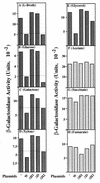A dual-signaling mechanism mediated by the ArcB hybrid sensor kinase containing the histidine-containing phosphotransfer domain in Escherichia coli
- PMID: 9683496
- PMCID: PMC107383
- DOI: 10.1128/JB.180.15.3973-3977.1998
A dual-signaling mechanism mediated by the ArcB hybrid sensor kinase containing the histidine-containing phosphotransfer domain in Escherichia coli
Abstract
The two components ArcB and ArcA play a crucial role in the signal transduction implicated in the complex transcriptional regulatory network that allows Escherichia coli to sense various respiratory growth conditions. ArcB is a hybrid sensor kinase having multiple phosphorylation sites in its primary amino acid sequence, including a transmitter, a receiver, and a histidine-containing phosphotransfer (HPt) domain. ArcA is a DNA-binding transcriptional regulator with a receiver domain. Results of recent in vitro studies revealed multistep His-to-Asp phosphotransfer circuitry in the ArcB-ArcA signaling system. For this report we conducted a series of in vivo experiments using a set of crucial ArcB mutants to evaluate the regulation of the sdh operon. The results suggested that the phosphorylated His-717 site in the HPt domain of ArcB is essential for anaerobic repression of sdh. Nonetheless, the ArcB mutant lacking this crucial His-717 site does not necessarily exhibit a null phenotype with respect to ArcB-ArcA signaling. The HPt mutant appears to maintain an ability to signal ArcA, particularly under aerobic conditions, which results in a significant repression of sdh. Based on these and other in vivo results, we propose a model in which ArcB functions in its own right as a dual-signaling sensor that is capable of propagating two types of stimuli through two distinct phosphotransfer pathways.
Figures




Similar articles
-
An Escherichia coli protein that exhibits phosphohistidine phosphatase activity towards the HPt domain of the ArcB sensor involved in the multistep His-Asp phosphorelay.Mol Microbiol. 1998 Feb;27(3):573-85. doi: 10.1046/j.1365-2958.1998.00703.x. Mol Microbiol. 1998. PMID: 9489669
-
The structure and function of the histidine-containing phosphotransfer (HPt) signaling domain of the Escherichia coli ArcB sensor.J Biochem. 1998 Aug;124(2):440-5. doi: 10.1093/oxfordjournals.jbchem.a022132. J Biochem. 1998. PMID: 9685739
-
Phosphotransfer circuitry of the putative multi-signal transducer, ArcB, of Escherichia coli: in vitro studies with mutants.Mol Microbiol. 1995 Dec;18(5):953-62. doi: 10.1111/j.1365-2958.1995.18050953.x. Mol Microbiol. 1995. PMID: 8825099
-
Cellular and molecular physiology of Escherichia coli in the adaptation to aerobic environments.J Biochem. 1996 Dec;120(6):1055-63. doi: 10.1093/oxfordjournals.jbchem.a021519. J Biochem. 1996. PMID: 9010748 Review.
-
Signaling by the arc two-component system provides a link between the redox state of the quinone pool and gene expression.Antioxid Redox Signal. 2006 May-Jun;8(5-6):781-95. doi: 10.1089/ars.2006.8.781. Antioxid Redox Signal. 2006. PMID: 16771670 Review.
Cited by
-
The ArcAB Two-Component System: Function in Metabolism, Redox Control, and Infection.Microbiol Mol Biol Rev. 2022 Jun 15;86(2):e0011021. doi: 10.1128/mmbr.00110-21. Epub 2022 Apr 20. Microbiol Mol Biol Rev. 2022. PMID: 35442087 Free PMC article. Review.
-
Metabolic Regulation of a Bacterial Cell System with Emphasis on Escherichia coli Metabolism.ISRN Biochem. 2013 Feb 18;2013:645983. doi: 10.1155/2013/645983. eCollection 2013. ISRN Biochem. 2013. PMID: 25937963 Free PMC article. Review.
-
The receiver domain of hybrid histidine kinase VirA: an enhancing factor for vir gene expression in Agrobacterium tumefaciens.J Bacteriol. 2010 Mar;192(6):1534-42. doi: 10.1128/JB.01007-09. Epub 2010 Jan 15. J Bacteriol. 2010. PMID: 20081031 Free PMC article.
-
Effects of limited aeration and of the ArcAB system on intermediary pyruvate catabolism in Escherichia coli.J Bacteriol. 2000 Sep;182(17):4934-40. doi: 10.1128/JB.182.17.4934-4940.2000. J Bacteriol. 2000. PMID: 10940038 Free PMC article.
-
RcsF is an outer membrane lipoprotein involved in the RcsCDB phosphorelay signaling pathway in Escherichia coli.J Bacteriol. 2006 Jun;188(12):4264-70. doi: 10.1128/JB.00004-06. J Bacteriol. 2006. PMID: 16740933 Free PMC article.
References
-
- Appleby J L, Parkinson J S, Bourret R B. Signal transduction via the multi-step phosphorelay: not necessarily a road less traveled. Cell. 1996;86:845–848. - PubMed
-
- Hoch J A, Silhavy T J. Two-component signal transduction. Washington, D.C: ASM Press; 1995.
-
- Inouye M. His-Asp phosphorelay; two components or more? Cell. 1996;85:13–14.
Publication types
MeSH terms
Substances
LinkOut - more resources
Full Text Sources
Molecular Biology Databases

